Japan
Wood Products Prices
Dollar Exchange Rates of 25th
June 2018
Japan Yen 110.04
Reports From Japan
2% Inflation eludes Bank of Japan
Recent data from Japan¡¯s Ministry of Internal Affairs and
Communications shows that the May consumer price
index rose 0.7% year-on-year, unchanged from April. This
index includes oil products but excludes fresh food.
Analysts were quick to point out that this underlines how
difficult it has been for the Bank of Japan to achieve its
2% inflation target despite over five years of massive
fiscal stimulus.
Against this background it is unlikely that the Bank of
Japan will halt its ultra-easy monetary policy while the
ruling majority government is in power.
The economy is expected to recover in the second quarter
from the contraction recorded in the first quarter but there
are many risks ahead especially the looming trade war
between the US and China.
Japan's consumer confidence weakened marginally in June
according to data released by the Cabinet Office.
The consumer confidence index dropped to 43.7 in June
from 43.8 in May. The index for livelihood fell to 41.9 in
June from 42.1 in the previous month. Similarly, the index
for income growth declined. But the gauge of willingness
to buy durable goods rose from the previous month.
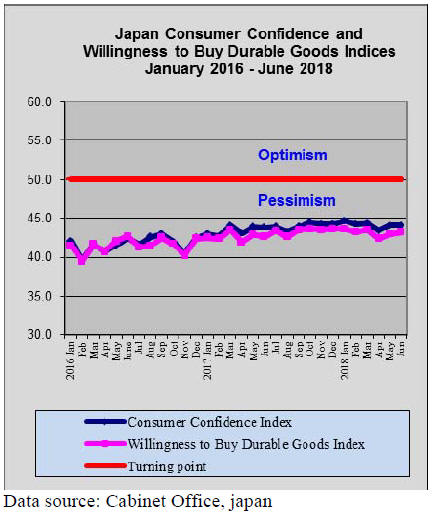
¡¡
Concerns on impact of looming trade war
The US dollar rate weakened against most other major
currencies in the second half of June driven down by fears
of escalating trade tensions between the United States and
its major trading partners. Currency traders are
increasingly concerned that the global economy may be
negatively affected.
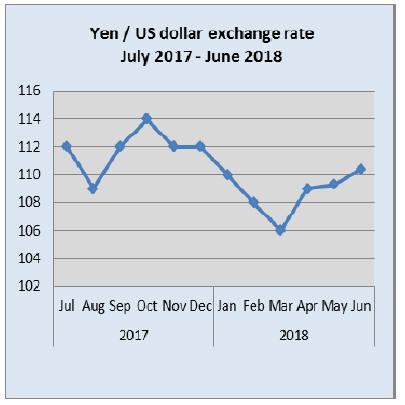
Unexpected June rise in housing starts
The May housing data from Japan¡¯s Ministry of Land,
Infrastructure, Transport and Tourism showed an
unexpected downturn from a month earlier despite being
slightly higher year on year. Housing starts were forecast
to drop 6% in May.
Factoring in the May data then annualised starts at
the
current rate would be 996,000.
The survey of construction companies revealed that orders
received by the major companies dropped almost 19%
year on year in May in contrast to April's rise.
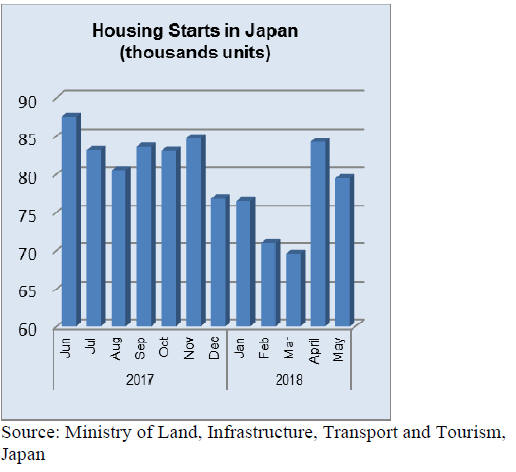
Import round up
Doors
March door imports
The sharp drop in the value of imports of wooden doors
(HS441820) in March was sustained into April. But Year
on year, April imports were some 4% up.
March imports were driven down by much lower
shipments from China and a modest decline in shipments
from the other main suppliers, the Philippines and
Malaysia.
As in previous months China was the major supplier
of
wooden doors to the Japanese market. Imports from China
accounted from 56% of total wooden door imports with a
further 18% from the Philippines, 10% from Indonesia and
7% from Malaysia. These four shippers accounted for over
90% of Japan¡¯s April wooden door imports
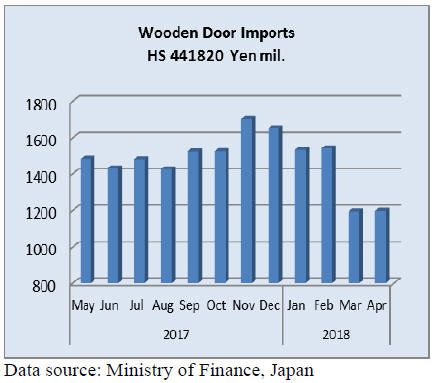
Window imports
April window imports
After the slight recovery in the value of wooden window
imports in March which reversed the downward trend
recorded in the previous two months, April imports
declined.
Year on year, April 2018 imports of wooden windows
were down just over 25% and compared to levels in March
there was a 10% decline.
The top three shippers of wooden windows to Japan in
April were the same as in March but shippers in China
displaced the US as the top supplier by a small margin.
In April China accounted for 32% of Japan¡¯s wooden
window imports followed by the US (28%) and the
Philippines (23%). There was a substantial import of
wooden windows from Sweden in April which acounted
for a further 9% of total wooden window imports.
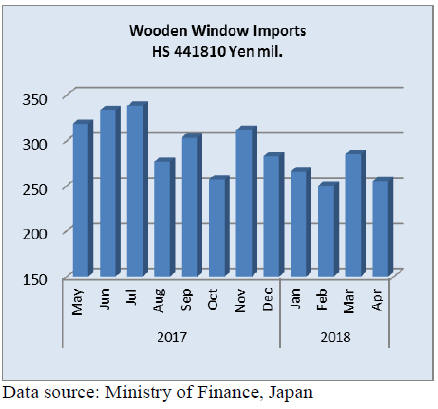
Assembled flooring
April imports
As in previous months wooden flooring imports were
dominated by HS 441875 followed by HS441879.
Together these two categories of assembled flooring
accounted for over 80% of the value of all assembled
wooden flooring imports.
In order of rank by value, China, Malaysia and Indonesia
were the main shippers of HS441875 in April while for
HS441879 the main shipper was Indonesia at 47% of all
shipments of this category of flooring followed by
Thailand at 15%.
From the beginning of 2018 the value of wooden flooring
imports into Japan has been falling. The upturn in April
imports marked the first sign of recovery in the year to
date. The reversal of the downturn in imports recorded in
February and March which was largely due to increased
imports of HS441875 from Indonesia and Thailand.

Plywood
April plywood imports
As in previuos months plywood in HS 441231 accounted
for most of Japan¡¯s imports of plywood.
In April HS441231 accounted for over 89% of all plywood
imports. HS441234 accounted for just 6% of April
plywood imports, HS441233, 4% and HS441239 less than
1% of imports.
Year on year April plywood imports from all sources rose
18% with both China and Indonesia recording sharp gains
in shippments to Japan.
In contrast exports of plywood from Malaysia to Japan fell
7% month on month in April but compared to a year
earlier there was little change. Restrictions on harvest
volumes and the lingering rain season had an effect on
April plywood shipments to Japan.
Plywood imports by main sources
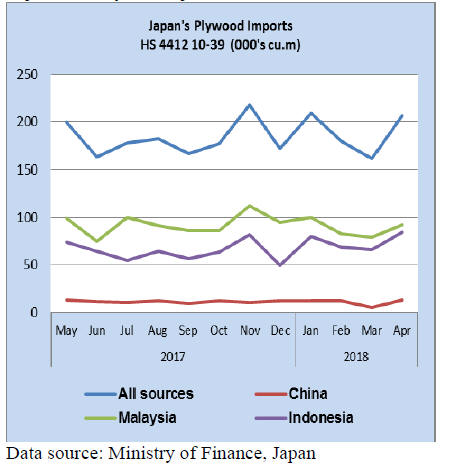

Trade news from the Japan Lumber Reports
(JLR)
The Japan Lumber Reports (JLR), a subscription trade
journal published every two weeks in English, is
generously allowing the ITTO Tropical Timber Market
Report to reproduce news on the Japanese market
precisely as it appears in the JLR.
For the JLR report please see:
http://www.nmokuzai.com/modules/general/index.php?id=7
Roof of the national stadium
Construction of large roof of the national stadium has
started since January this year. Three companies,
Sumitomo Forestry, Emachu group and Japan Kenzai are
engaged in assembling wooden parts and installation for
the large roof of the new national stadium.
The roof is truss structure with combination of steel and
laminated lumber of cedar and larch. All the wood is
forestry certified and preservative treated. Wood is visible
from all the seats of the stadium.
Main part is steel with sufficient strength then wood is
combined to prevent deformation by strong wind and
earthquake. Wood is used inside of the roof where rain
does not reach but to give durability, wood is preservative
treated to prevent rotting.
The roof is designed to last 100 years without any major
repair but for regular maintenance, movable gondola under
the truss, corridor for inspection inside truss and access
route to roof top are installed. The new stadium will be
used for the 2020¡¯s Olympic Games.
Wood statistics of 2017
The Ministry of Agriculture, Forestry and Fisheries
publicized wood statistics of 2017. Housing starts in 2017
were less than 2016 but supply of domestic logs was
21,279,000 cbms, which is the highest since 1997. Driving
factor is increase for lumber use with 12,632,000 cbms,
3.7% more than 2016.
Imported wood was 5,059,000 cbms. Logs from New
Zealand increased but logs from Russia, South Sea and
North America decreased. In particular, logs from North
America were 3,882,000 cbms, 5.5% less than 2016.
Total log supply in 2017 was 26,337,000 cbms. Logs for
lumber were 16,802,000 cbms, 1.3% more than 2016.
Logs for plywood were 4,875,000 cbms, which include
logs for CLT. Logs for wood chip were 4,66,000 cbms,
2.0% less. Domestic logs for lumber and plywood
increased but imported logs decreased.
Meantime, lumber import in 2017 was 0.1% more than
2016 and plywood import decreased by 8.2%. Wood chip
import increased by 2.2%.
Generally, domestic log use for lumber and plywood
increased while domestic production of wood chip
decrease and import increased.
Lumber shipments in 2017 were 9,457,000 cbms, 1.8%
more than 2016 out of which percentage of kiln dried
lumber was 41.4%. This is the first time that a percentage
passed over 40%.
In shipments, lumber for construction increased by 1.9%.
In these, a percentage of board increased by 14.1% while
square increased only by 1.7%. Lumber for crating and
furniture recovered from decline in 2016. Limber for
engineering works construction decreased.
Domestic logs for plywood increased by 311,000 cbms.
By species, cypress and fir increased while larch declined.
In imported logs, logs from South Sea countries and
Russia decreased while logs from North America and New
Zealand increased. Increase of New Zealand logs is mainly
for LVL manufacturing.
In domestic log producing regions, prefectures producing
over one million cbms are Hokkaido, Miyazaki, Iwate and
Akita. Ranking has not changed from 2016 but the
production of Akita and Miyagi decreased from 2016.
Others like Fukushima, Tochigi and Fukuoka increased
the production over 100,000 cbms from 2016.
Plywood
Movement of softwood plywood is getting stagnant and
some low priced offers are around but orders from large
precutting plants are steady so basically the market is firm.
April domestic softwood plywood production was 260,200
cbms, 3.2% more than April last year and 2.4% less than
March, out of which structural panel production was
239,300 cbms, 0.8% less and 3.7% less. Shipment of
softwood plywood was 250,700 cbms, 0.5% less and 0.4%
less.
The demand for March and April was slow but the
manufacturers continued full production to catch up
delayed orders and build up the inventory. Users try to
have extra volume to prepare fall demand pickup. The
market is optimistic for the demand through the year,
Softwood plywood inventory in April was 127,700 cbms.
Imported plywood movement remains slow despite low
arrivals. The suppliers continue passing higher log cost
onto future plywood offers.
Domestic logs and lumber
Log production is slowing toward rainy season. This is the
most slow season until fall. Sawmills reduce log purchase
since log quality is easy to deteriorate so log prices tend to
weaken. Lumber movement continues slow even after the
holiday season was over in early May
Changing crating lumber materials
New Zealand radiata pine logs used to be major material
for crating lumber but after China becomes major buyer,
log prices continue climbing and sawmills are not able to
pass higher cost onto lumber.
Substituting Chilean radiata pine lumber supply becomes
seller¡¯s market as worldwide wood demand keeps
expanding and Japan cannot buy enough volume and
specifications are not as free as before. In short, Japan has
to swallow what suppliers give.
Crating lumber is not high priced item in lumber market.
Lumber from other sources like North America and South
Sea countries is also used for crating but lumber prices
from these sources are also inflating by competition of
other markets.
What is needed depends on type of cargoes. For heavy
cargoes, sturdy lumber is needed like keruing and kapur
from South Sea countries but they are now hard to come
by so others like agathist and melapi from Malaysia and
planted species of taun and callophylum from PNG
replace and particleboard is one of replacing item.
Crating lumber assembly plants select suitable
species by
type of cargoes or buyers¡¯ order. Domestic cedar is the
most likely substituting material now. Hokkaido larch has
been main crating material for years. Larch is strong and
water resistant but appearance is not so good as
construction material so it has been used for crating and
sill.
Cedar has abundant resource but lacks strength so it is not
considered as good crating material but it is usable as
crating board. Assembly plants select various materials
and combined package like domestic cedar and North
American hemlock is now popular. Assembly plants make
wooden box, wire drum and pallet.
Pallet is another major wooden product but due to high
cost of wood, plastic and metal pallet are gradually
increasing.
According to the Japan Pallet Association, annual
production of pallet is about 60 million pieces out of
which wood pallet is about 40 million. Plastic pallet is
about 10 million and metal pallet is two million. Average
cost of wood pallet is less than 30,000 yen and of plastic is
about 35,000 yen. Metal is over 100,000 yen. Recycled
wood pallet prices are less costly at 10,000-13,000 yen.

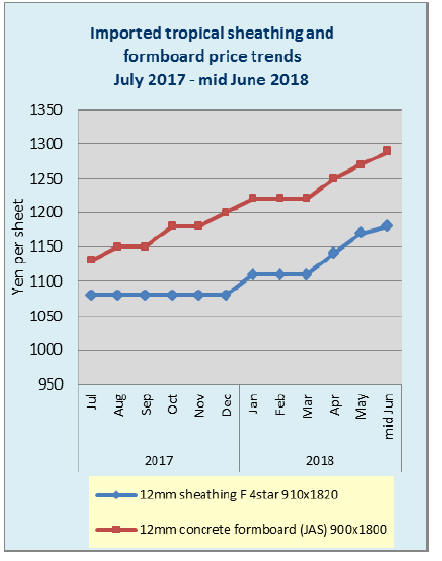
|